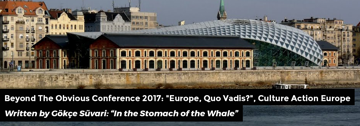KPY
Beyond the Obvious Conference 2017: "Europe, Quo Vadis?", Cultur Action Europe / Written by Gökçe Süvari: "In the Stomach of the Whale

March '17
In the Stomach of the Whale
The sub title of this year’s “Beyond The Obvious” (BtO) conference that is organized every year since 2015 by Culture Action Europe (CAE) in partnership with United Cities and Local Governments (UCLG) was “Europe, Quo Vadis?” (Where Does Europe Go?). During the conference that took place in Budapest at the end of last January, the agenda of the participants including cultural managers, producers and activists was the cultural policies of post-Brexit Europe which is trying to confront the phenomenon of migration.
The participants at the Bálna (Whale) cultural center situated along the banks of the Danube River were particularly concerned about the extent to which decision mechanisms in local cultural politics included cultural producers.
Another issue on the agenda was the challenges encountered by the elected cities as the European Capital of Culture for the upcoming years and the strategies they developed to tackle them. The importance of long-term cultural strategies that set forth sustainability, social inclusion, participatory policies and cultural diversity was one of the topics that the participants agreed on. In addition to that, the importance of preventing the brain drain, capacity development and politics that take public space in to account was underlined. A striking suggestion regarding local governments that envision cultural development was the urgency of investing in people and the creative content and not the space in their cultural policies.
In the context of developing, large and middle scaled cities, the common opinion was that the cities that position culture as the basis of all strategic documents became successful practices.
The primary questions that came up during the “Quo Vadis, Europa?” session at the last day of the event were controversial topics such as “how identity and belonging is being defined?” and “do the politics obstruct the formation of a polyphonic society?” in these days, “is the European identity still being defined through Jewish-Christian tradition?” and “how effective is it to create borders and what should replace it?”
The whale's stomach in glass hosting the Beyond the Obvious was a unique space that brought together different ideas and examples for three days full of conferences, presentations and workshops in order to rethink about the culture, share different stories and experiences, discuss about the future and look beyond the obvious.
Text and photography: Gökçe Süvari
About Bálna:
The Bálna design, the historical brick building and the concrete structures typical of the last century are embraced in a computer designed metal-glass shell. The interior shaping of Bálna faithfully reflects today’s holistic approach: steel, aluminum and glass, yellow-burned bricks, bone-coloured concrete and silk-grey aluminum surfaces, mirror-polished concrete and wood flooring, terrazzo-pattern staircases and chrome steal escalators reflect the sunshine that lights through the transparent glass ceiling. Bálna also serves as the home to Budapest Gallery.
Interview with Jordi Pascual:
Interviewer: Gökçe Süvari
Beyond the Obvious: Europe, Quo Vadis? // Interview with Jordi Pascual (Türkçe Altyazılı) from Bilgi KPY on Vimeo.